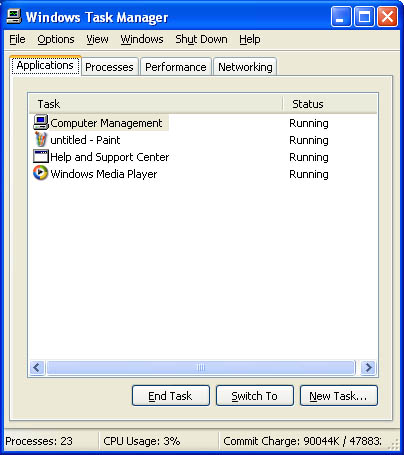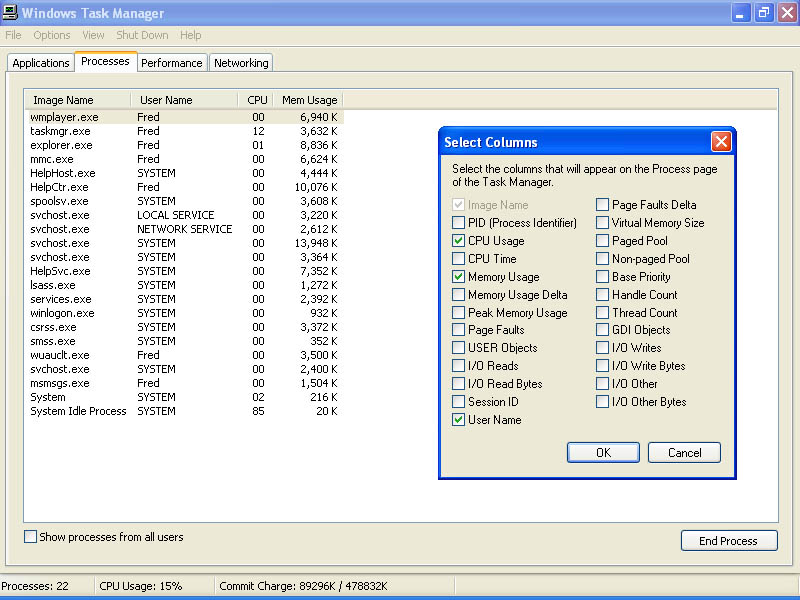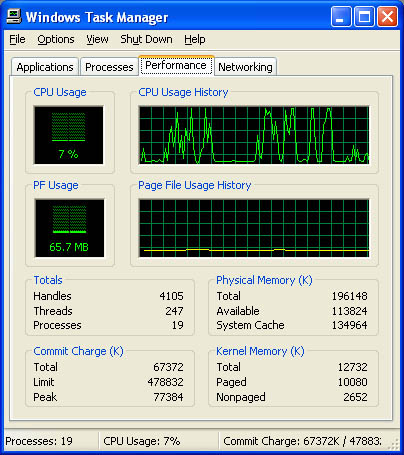Lesson 6: Using Task Manager
Lesson 6:?Using Task Manager
Task Manager provides information about the programs and processes running on your computer and the performance of your computer. You can use Task Manager to start programs, to stop programs and processes, and to view a dynamic view of your computer's performance.
After this lesson, you will be able to
- Identify three methods for starting Task Manager
- Use Task Manager to monitor programs, processes, and system performance
- Add columns to the Processes tab display
- Use Task Manager to start and stop programs
Estimated lesson time: 25 minutes
Monitoring Programs
Task Manager allows you to monitor applications and processes currently running on your computer. It also provides information about the processes, including the memory usage of each one. It provides statistics about the memory and processor performance and network usage. You can start Task Manager in any of the following three ways:
- Press Ctrl+Shift+Esc
- Right-click the Windows taskbar, and then click Task Manager
- Press Ctrl+Alt+Delete
The Task Manager dialog box shown in Figure 15.8 has four tabs: Applications, Processes, Performance, and Networking.

You can use the options in the Applications tab of the Task Manager dialog box to stop a program from running (End Task), to switch to a program and bring the program into the foreground (Switch To), and to start a program (New Task). At the bottom of the display, Task Manager shows you the number of processes currently running, the CPU usage, and the memory usage.
Monitoring Processes
The Processes tab in the Task Manager dialog box (see Figure 15.9) lists all processes currently running on your computer that run in their own address space, including all applications and system services. Task Manager also allows you to end processes.

By default, the Processes tab shows you the processes, the users running each process, and the CPU and memory usage for each process that is running. You can add additional performance measures to those shown by default in the Processes tab. To add performance measures, on the View menu, click Select Columns (see Figure 15.9). Table 15.8 describes the columns that are displayed in Task Manager by default and some of the columns that can be added to the Processes tab.
Table 15.8??Processes Tab Columns
Monitoring System Performance
You can use the Performance tab in the Task Manager dialog box (see Figure 15.10) to see a dynamic overview of system performance.

Table 15.9 describes the fields that are displayed in Task Manager by default in the Performance tab.
Table 15.9??Performance Tab Fields
Monitoring Networking
The Networking tab in the Task Manager dialog box lists the adapter name, the network utilization, the link speed, and the state of the connection.

Practice:?Using Task Manager
In this practice, you use Task Manager to monitor programs, processes, and system performance. You use Task Manager to start a program and to stop a program. Finally, you add new columns to the Processes tab.

Run the TaskManager file in the Demos folder on the CD-ROM accompanying this book for a demonstration of using Task Manager.
To monitor programs, processes, and system performance
- If necessary, log on as Fred or with a user account that is a member of the Administrators group.
- Press Ctrl+Shift+Esc to launch Task Manager.
What programs are currently running on your system?
- Click New Task.
Windows XP Professional displays a Create New Task dialog box.
- In the Open text box, type wordpad and click OK.
WordPad should start and be listed as a running application.
- Click the Processes tab.
How many processes are running?
- On the View menu, click Select Columns.
The Select Columns dialog box appears.
- Click Peak Memory Usage, and then click Page Faults. Click OK.
Two new columns, Peak Memory Usage and Page Faults, are added to the Processes tab display. You might need to maximize Task Manager to see all columns.
- Click the Performance tab.
What percentage of your CPU's capacity is being used?
Do you think that your CPU could be slowing down the performance on your system?
- Click the Applications tab.
- Click WordPad and then click End Task.
WordPad closes and is removed from the list of running applications.
- Close Task Manager.

Lesson Review
The following questions will help you determine whether you have learned enough to move on to the next lesson. If you have difficulty answering these questions, review the material in this lesson before beginning the next lesson. The answers are in Appendix A, "Questions and Answers."
- Which of the following methods can you use to start Task Manager? (Choose all answers that are correct.)
- Press Ctrl+Alt+Esc
- Right-click the Desktop and click Task Manager
- Press Ctrl+Shift+Esc
- Press Ctrl+Alt+Delete and, if necessary, click Task Manager
- Which of the following tabs can be found in Task Manager? (Choose all answers that are correct.)
- Networking tab
- Programs tab
- Processes tab
- General tab
- What are page faults? Do you think a larger or smaller number of page faults indicate better system performance? Why?
- What does CPU usage represent? In general, is system performance better with a high CPU usage value or a low value?
Lesson Summary
- You can use Task Manager to monitor applications and processes currently running on your computer, as well as to monitor memory and processor performance and network usage.
- You can use the Applications tab of Task Manager to stop a program, switch to a program, and start a program.
- After you have scheduled a task to run, you can still modify any of the options or advanced features for the task, including the program to be run.
- You can add additional columns to the Processes tab.







